Click on images to enlarge

infestation (Photo: Sheldon Navie)
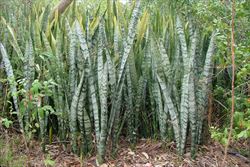
habit (Photo: Sheldon Navie)
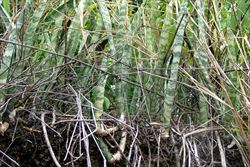
habit showing a few exposed rhizomes (Photo: Sheldon Navie)
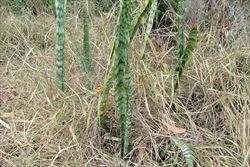
habit in fruit (Photo: Sheldon Navie)
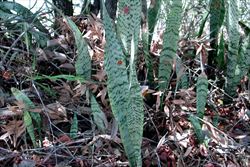
elongated variegated leaves (Photo: Sheldon Navie)

close-up of leaf with green margins (Photo: Sheldon Navie)
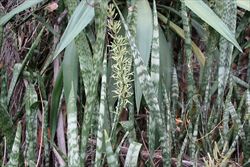
elongated flower cluster (Photo: Sheldon Navie)
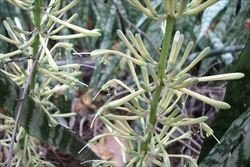
greenish-white coloured tubular flowers (Photo: Sheldon Navie)
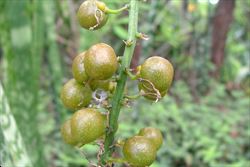
close-up of immature fruit (Photo: Sheldon Navie)
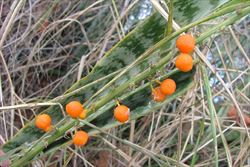
mature fruit (Photo: Sheldon Navie)
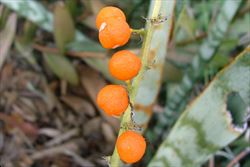
close-up of bright orange mature fruit (Photo: Sheldon Navie)
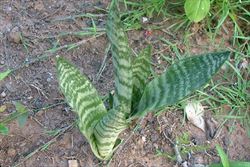
young shoots (Photo: Sheldon Navie)

habit of variegated mother-in-law's-tongue, Sansevieria trifasciata 'Laurentii' (Photo: Sheldon Navie)
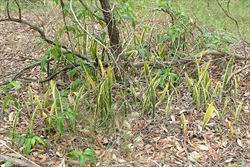
infestation of variegated mother-in-law's-tongue, Sansevieria trifasciata 'Laurentii' (Photo: Sheldon Navie)

close-up of the leaves of variegated mother-in-law's-tongue (Sansevieria trifasciata 'Laurentii') showing the broad yellow margins (Photo: Sheldon Navie)
Scientific Name
Sansevieria trifasciata Prain
Synonyms
For Sansevieria trifasciata 'Laurentii':
Sansevieria laurentii De Wild.Sansevieria trifasciata Prain var. laurentii (De Wild.) N.E. Br.
Family
Dracaenaceae (New South Wales and Queensland)Liliaceae (Northern Territory)
Common Names
African bowstring hemp, bowstring hemp, good luck plant, mother in law's tongue, mother-in-law's tongue, snake plant, snakeplant, viper's bowstring hemp
Origin
Native to some parts of tropical western Africa (i.e. Zaire and northern Nigeria).
Cultivation
Mother-in-law's tongue (Sansevieria trifasciata) has been widely cultivated in gardens and as an indoor plant. It is still popular and several modern cultivars are now available (e.g. 'Moonshine', 'Golden Hahnii', 'Silver Hahnii' and 'Bantel's Sensation'). However, the most commonly grown cultivars of this species are the older variegated mother-in-law's tongue (Sansevieria trifasciata 'Laurentii') and the dwarf mother-in-law's tongue (Sansevieria trifasciata 'Hahnii').
Naturalised Distribution
Widely naturalised in eastern Australia (i.e. throughout eastern Queensland and in the coastal districts of northern New South Wales). Also naturalised near Darwin, in the north-western parts of the Northern Territory, and on Lord Howe Island.
Naturalised overseas in south-eastern USA (i.e. Florida), the Caribbean (i.e. Puerto Rico and the Virgin Islands) and on several Pacific islands (e.g. the Cook Islands, Fiji, Palau, Western Samoa and Hawaii).
Habitat
A weed of roadsides, abandoned gardens, waste areas, disturbed sites, coastal environs, open woodlands, riparian vegetation and the margins of closed forests in tropical, sub-tropical and warmer temperate regions.
Habit
A spreading or clumping plant with a network of creeping underground stems (i.e. rhizomes) that send up shoots. These shoots produce clusters of upright (i.e. erect) leaves up to 1 m or more tall. The creeping stems (i.e. rhizomes) may occasionally be present on or just above the soil surface.
Distinguishing Features
-
a spreading or clumping plant with a network of creeping underground stems.
-
its large, elongated, sword-shaped leaves (30-120 cm long and 2.5-9 cm wide) are arranged in small upright clusters.
-
these long-lived leaves are somewhat fleshy and have sharply-pointed tips.
-
they are irregularly striped with dark green and pale whitish-green.
-
its whitish coloured flowers (25-30 mm long) have six narrow 'petals' that are partially fused as the base.
-
its rounded berries (7-9 mm across) turn bright orange when mature.
Stems and Leaves
The creeping underground stems (i.e. rhizomes) are relatively thick and somewhat fleshy (i.e. succulent) in nature. They are usually bright orange in colour on the outside and whitish on the inside.
The large sword-shaped (i.e. ensiform) or elongated (i.e. lanceolate) leaves are borne upright (i.e. erect) and are usually arranged in small clusters of 2-6 leaves. These leaves (30-175 cm long and 2.5-9 cm wide) are rather thick and somewhat fleshy (i.e. succulent) in nature with sharply-pointed tips (i.e. acute apices). They have entire margins, are hairless (i.e. glabrous), and are usually quite long-lived. Both leaf surfaces are dark green in colour and irregularly striped and banded with pale green or whitish-green (i.e. they are variegated).
Flowers and Fruit
The upright flowering stems (i.e. erect scapes) are relatively slender and are usually shorter than the leaves (30-75 cm long). They bear numerous flowers in an elongated clusters near their tips (i.e. in a terminal raceme). The flowers (2.5-3 cm long) are white, yellowish-white or greenish-white in colour and are usually arranged groups of 1-3 along the flowering stems. These flowers have six 'petals' (i.e. perianth segments) that are partially fused into a tube (i.e. perianth tube) 6-12 mm long and separate into six spreading lobes (15-20 mm long) at their tips. These lobes (i.e. perianth lobes) are quite narrow (i.e. linear) and are usually bent backwards (i.e. they are recurved) when the flowers are fully open. Each flower is borne on a stalk (i.e. pedicel) 6-8 mm long and also has six stamens (7-8 mm long) and a long style (15-18 mm long) topped with a small stigma. Flowering occurs mostly during spring and summer (i.e. from September to February).
The small rounded (i.e. globose) fruit is a berry that turns from green to bright orange in colour as it matures. These fleshy fruit (7-9 mm across) contain two seeds. The seeds (6-7 mm long and about 5 mm wide) are pale brown and oblong shaped.
Reproduction and Dispersal
This species reproduces by seed and also vegetatively via its creeping underground stems (i.e. rhizomes).
The seeds are mainly dispersed by birds and other animals that eat the brightly coloured fruit. The creeping underground stems (i.e. rhizomes) can spread some distance and greatly increase the size of colonies. However, the main means of dispersal of this species to new areas is via the dumping of pieces of the underground stems (i.e. rhizome segments) in garden waste.
Environmental Impact
Mother-in-law's tongue (Sansevieria trifasciata) is regarded as an environmental weed in Queensland, New South Wales and the Northern Territory, and as a "sleeper weed" in other parts of Australia.
Legislation
Not declared or considered noxious by any state government authorities.
Similar Species
Mother-in-law's-tongue (Sansevieria trifasciata) is a quite distinctive species. However, there is another very similar plant naturalised in Queensland (i.e. Sansevieria liberica). These two species can be distinguished by the following differences:
- mother-in-law's-tongue (Sansevieria trifasciata) has relatively narrow leaves (2.5-7 cm wide) that are usually very upright in nature. These leaves are distinctly variegated with paler green or whitish-green bands and have green or occasionally yellowish-coloured margins.
- African bowstring hemp (Sansevieria liberica) has slightly broader leaves (5-12.5 cm wide) that are usually slightly spreading in nature. These leaves are somewhat variegated with indistinct paler green or whitish-green bands and have orange or reddish-brown coloured margins.
There is also a common cultivar of mother-in-law's-tongue (Sansevieria trifasciata) with broad pale yellow leaf margins. This plant is known as variegated mother-in-law's-tongue (Sansevieria trifasciata 'Laurentii') and is also occasionally present in naturalised populations.

